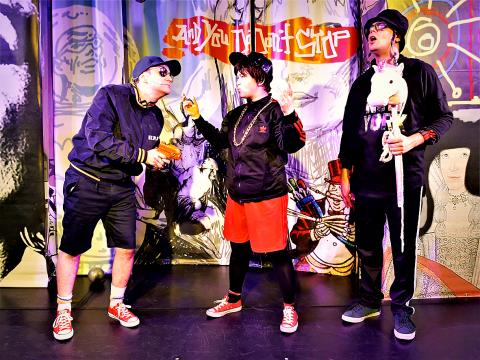It’s witty, funny, bold and at times irreverent. It’s Shakespeare as you’ve never seen or heard him before as the LAB Space closes out the year with Bomb-itty of Errors, a hip-hop version of the Bard’s The Comedy of Errors. It’s a show that you won’t want to miss.
Two sets of identical twins, Antipholus and Dromio, are separated at birth and raised in the different cities of Syracuse and Ephesus. The complications begin when the Syracuse Antipholus and Dromio, as joyful vagabonds, come to sedate Ephesus where they are both mistaken for their similarly named counterparts and quickly become enmeshed in their affairs.
Director Brook Hall has put together a strong cast of Steve Coetzee and Airy Liu (劉怡伶), the Syracuse Antipholus and Dromio, and Meg Anderson and Charlie Storrar, the Ephesus Antipholus and Dromio, to carry this delightful farce.

Photo courtesy of Antonella Gismundi
From here on in, one needs a touch of Samuel Taylor Coleridge’s “willing suspension of disbelief.”
In Shakespeare’s day, men played the women’s roles and actors spoke in iambic pentameter. Rap is often iambic tetrameter and the real delight of this play is the versatility shown by the four leads as they take on multiple roles and rap in style.
Everyone will have his/her favorite scenes. For this writer, it is Hasidic Hendelberg (Coetzee) getting lost in his own rap.
Another is when Storrar as Luciana is alarmingly “courted” by Syracuse Antipholus (Coetzee) whom “she” thinks is her sister’s husband.
Kudos go to costume designer Jenna Robinette, set designer Joseph Lark-Riley and show sponsorship from the Department of Culture, Taipei City Government. Not only are multiple costumes needed but ones that can come off and on in a split second as characters exit one door and return through another.
Lark-Riley’s graffiti-laced set provides the multiple entrances and exits as well as a visible balcony for “beat man,” DJ Cross Cutz (Cedric Bouadzi), who regularly interacts with the cast below.

Most heroes are remembered for the battles they fought. Taiwan’s Black Bat Squadron is remembered for flying into Chinese airspace 838 times between 1953 and 1967, and for the 148 men whose sacrifice bought the intelligence that kept Taiwan secure. Two-thirds of the squadron died carrying out missions most people wouldn’t learn about for another 40 years. The squadron lost 15 aircraft and 148 crew members over those 14 years, making it the deadliest unit in Taiwan’s military history by casualty rate. They flew at night, often at low altitudes, straight into some of the most heavily defended airspace in Asia.

This month the government ordered a one-year block of Xiaohongshu (小紅書) or Rednote, a Chinese social media platform with more than 3 million users in Taiwan. The government pointed to widespread fraud activity on the platform, along with cybersecurity failures. Officials said that they had reached out to the company and asked it to change. However, they received no response. The pro-China parties, the Chinese Nationalist Party (KMT) and Taiwan People’s Party (TPP), immediately swung into action, denouncing the ban as an attack on free speech. This “free speech” claim was then echoed by the People’s Republic of China (PRC),

Many people in Taiwan first learned about universal basic income (UBI) — the idea that the government should provide regular, no-strings-attached payments to each citizen — in 2019. While seeking the Democratic nomination for the 2020 US presidential election, Andrew Yang, a politician of Taiwanese descent, said that, if elected, he’d institute a UBI of US$1,000 per month to “get the economic boot off of people’s throats, allowing them to lift their heads up, breathe, and get excited for the future.” His campaign petered out, but the concept of UBI hasn’t gone away. Throughout the industrialized world, there are fears that

Like much in the world today, theater has experienced major disruptions over the six years since COVID-19. The pandemic, the war in Ukraine and social media have created a new normal of geopolitical and information uncertainty, and the performing arts are not immune to these effects. “Ten years ago people wanted to come to the theater to engage with important issues, but now the Internet allows them to engage with those issues powerfully and immediately,” said Faith Tan, programming director of the Esplanade in Singapore, speaking last week in Japan. “One reaction to unpredictability has been a renewed emphasis on